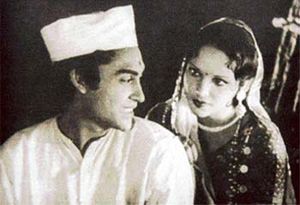Devika Rani Chaudhuri Roerich (Bengali: দেবিকা রাণী) (30 March 1908 – 9 March 1994) was an early Indian movie star.
Career
Born in Waltair (now Visakhapatnam), Devika Rani came from a distinguished background: she was the great-grandniece of the Nobel Laureate Rabindranath Tagore and her father, Col. M. N. Chaudhuri, was the first Indian Surgeon-General of Madras. Her mother's name was Leela.
She completed her early schooling in the early 1920s. She then studied drama at the Royal Academy of Dramatic Art (RADA) and the Royal Academy of Music in London, UK, where she won scholarships. She also studied architecture, textile and decor design, and apprenticed under Elizabeth Arden. Here, through her Brahmo connections, she met with scriptwriter Niranjan Pal who would eventually write many of her most successful screen roles.
Devika Rani married Indian producer and actor Himanshu Rai in 1929. Together they starred in Karma (1933). They soon founded the Bombay Talkies film studio, along with retainers Niranjan Pal and Franz Osten, whose films challenged the caste system. In addition to Devika Rani, other notable actors to work for Bombay Talkies at one point or another included Ashok Kumar and Madhubala.

Devika Rani and Ashok Kumar in Achhut Kanya (1936).
In 1936, Devika Rani eloped with her lover actor Najam-ul-Hassan.
Himanshu Rai somehow managed to bring her back but her paramour did not
return. And the studio head Himanshu Rai called upon his laboratory
assistant Ashok Kumar
to take the leading man's part and thus began a six-decade-long acting
career for that actor. Ashok Kumar later starred with the actress in Achhut Kanya (1936). This, her most notable film, is the story of a relationship between an untouchable girl (played by herself) and a Brahmin boy (played by Ashok Kumar).
Devika Rani is also accredited for having acted in the longest kissing scene in the movie world with her husband Himanshu Rai in Karma (1933). It was 4 minutes long and very controversial in the then culturally orthodox India.[1]
Later life

Devika Rani kissing Himanshu Rai in Karma (1933).
Widowed in 1940, she fought for control of her husband's studio Bombay Talkies, she had to share control with Sashadhar Mukherjee, but in 1943 Sashadhar, Ashok Kumar and a lot of Bombay talkies veterans left and formed a new studio - Filmistan. After that Bombay Talkies started to fade and she married Russian painter Svetoslav Roerich in 1945.
She left films and joined her husband in Bangalore[2] in their sprawling estate 'Tataguni' on Kanakpura Road, where she lived till her death in 1994, though maintained her link with the film industry.
In 1958, the President of India honoured Devika Rani with a Padma Shri. In 1969, she became the first recipient of the prestigious film prize, the Dadasaheb Phalke Award.
At her funeral, Devika Rani was given full state honors.
The Tataguni estate became famous for the dispute that ensued over it
after her death as the Indian and Russian governments and relatives
went to court over its control.
Trivia
- Devika Rani is best remembered for her discovery of Dilip Kumar.
- She was a student of architecture in London and met Himanshu Rai there, where she had agreed to design the sets for his film production....
- Mr.Rai was the only Indian producer with the famous German film concern U.F.A. in Berlin. At the U.F.A. Studios, Devika Rani learnt costumes designing, make-up, decor and other different branches of film production with special training in acting.
- At the time, Devika Rani also acted with Himansu Rai in a play for U.F.A. which took them to Switzerland and the Scandinavian countries, where they were received with the highest honours.
- It was in "KARMA" that Devika Rani established herself as a "star" of first magnitude. During the screening of "KARMA", Devika Rani was honoured by an invitation of the B.B.C. at London to act in the first television broadcast in Britain which was relayed throughout the country. She was also chosen to inaugurate the first B.B.C. broadcast on the short wavelength to India.
- She was a member of the Central Government Audio Visual Education Board.
- She was also nominated to the National Academy of Dance, Drama, Music and Films, the Sangeet Natak Akademi, Delhi, as a nominee of the Central Government.
- She was a member of the Executive Board of the National Academy, Member of the Lalit Kala Akademi and the National Handicrafts Board and Member of the Indian Council for Cultural Relations.
- Equally invaluable is the prestigious Soviet Land Nehru award conferred on her in 1989.
 Family background
Family background
Devika Rani was the great grandniece of Rabindranath Tagore.
Devika Rani's maternal grandmother Indumati Devi was the daughter of
Tagore's elder sister Saudamini Devi; she thus is related matrilineally
to Tagore. Her father M N Chaudhuri also belonged to an illustrious
family of Bengal. Her uncles, i.e. her father's brothers, were famous
men, like Justice Sir Ashutosh Chaudhuri, Barrister Jogesh Chandra Chaudhuri, and author Pramatha Chaudhuri.
0 comments:
Post a Comment